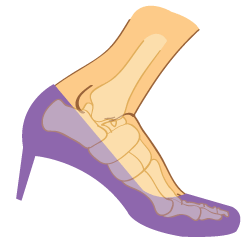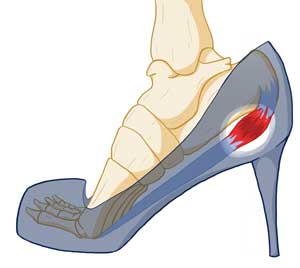 Normal foot weight distribution is split evenly – 50% at the heel of the foot and 50% at the ball of the foot, with an elevation in the heel the weight distribution changes and 90% of the body weight is now concentrated in the ball of the foot and 10% in the heel.
Normal foot weight distribution is split evenly – 50% at the heel of the foot and 50% at the ball of the foot, with an elevation in the heel the weight distribution changes and 90% of the body weight is now concentrated in the ball of the foot and 10% in the heel.
On a medium to higher heel the increased bowing of the arch on the bottom of the foot can lead to a shortened plantar fascia. The plantar fascia ligament helps support the arch of the foot. Over time the fascia can become vulnerable to strain or tearing when the lower heels or even no heels are worn because the foot is not used to having the plantar fascia stretch that way.
Having high heels with pointy toes, having narrow toe boxes lead to very little room for the toes. Along with too little toe space and over activity of the muscles on the bottom of the foot to keep the body stable while in a high heeled shoe, hammer toe deformities can often develop.
 Along with affecting the plantar fascia, high heeled shoes can lead to the shortening of the Achilles tendon which is attached to the calf muscle in the back of the leg. In women who wear high heeled shoes habitually, they often report chronic pain or aching in the calf muscle and Achilles tendon.
Along with affecting the plantar fascia, high heeled shoes can lead to the shortening of the Achilles tendon which is attached to the calf muscle in the back of the leg. In women who wear high heeled shoes habitually, they often report chronic pain or aching in the calf muscle and Achilles tendon.
Bursitis has also been reported in women who switch from a higher heel to a lower heeled shoe as the body tries to adapt to walking differently. The bursa that is located in the back of the heel is also affected by the change and function of the Achilles tendon causing bursitis in the back of the heel bone.
High heels may look very fashionable but prolonged and extensive use of these kinds of shoes can lead to many disabling deformities ranging from low back pain to chronic foot pain.